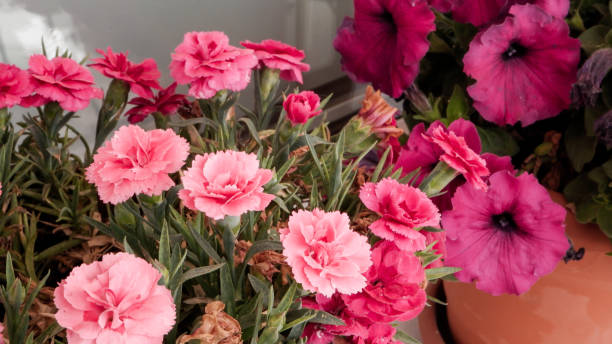Chinese Pink, or Dianthus chinensis, is a stunningly showy flower, prized for its impactful white and pink contrasting flat petals that are heavily fringed with a dark central eye. These delicate, pretty blooms sit on slender stems alongside narrow leaves, making them ideal for beds, edging, and containers. The biennial or short-lived perennial is a delight to both the eye and the garden.
Etymology of Dianthus Chinensis
The species name chinensis is derived from its country of origin, China. It belongs to the carnation family, called Caryophyllaceae, which is derived from the Greek words karyon, meaning “nut”, and phyllon, meaning “leaf”. As well as Chinese Pink, it is also known as Chinese Pink Dianthus, Dainty Pink, Striped Carnation, and Sweet William.
How to Plant and Grow
Chinese Pink requires well-draining soil in full sun to partial shade to thrive. Plant in spring or autumn when temperatures are moderate during the day variety and cool at night. Peak bloom time is usually toward the end of summer when bulbs and tubers have filled the flowering garden.
Regular watering is essential to keep the soil moderately damp throughout the growing season. Monitor soil moisture closely, and water the plant when the top layer of soil begins to dry. If too much water is left standing, it may lead to root rot. Chinese Pink require fertilizers such as a slow-release granular fertilizer. Prune off spent flowers and brown foliage to encourage new blooms.
Meaning and Symbolism
Chinese Pink is often given to express love and admiration and sometimes to express sympathy. Chinese Pink are said to be the symbol of lasting beauty, remembrance and undying love, which is often why they’re chosen as funeral flowers. Its five-petaled, fringed shape is symbolic of everlasting love.
History, Mythology, and Religious Significance
The ancient Greeks adored Chinese Pink and so, during the reign of Emperor Nero, it was known as ‘The Flower of Rome.’ The plant was brought to Europe in the 16th century by Spanish explorers and was very popular in the 19th century, used extensively in gardens and cut flower bouquets.
In China, the flower’s stamens and petals are often compared to the antlers of a deer and thus, the flower is seen as a symbol of luck and prosperity. The flower is also associated with the Greek tale of Adonis and Aphrodite, as well as being presented as a gift to the Chinese goddess Mazu.
Flower Varieties and Their Defining Characteristics
The Chinese Pink has two main varieties, the Tall China Pink, or Dianthus chinensis, and the smaller Sweet William, or Dianthus barbatus. Tall China Pink grows to a height of about 2 feet and produces extravagant, vibrant blooms in white, red, and shades of pink that are fringed with a deep red central eye. Sweet William, on the other hand, grows up to 8 inches and produces clusters of bright, double blooms in white, purple, and red with a fringed center.
How to Pot and Repot Chinese Pink
To keep your Chinese Pink blooming all season, you’ll need to plant and pot it correctly. Start by ensuring the pot has ample drainage holes and, depending on how large the plant is, fill it with a potting mix that is two-thirds potting soil and one-third perlite. Consider adding a bit of slow release fertilizer to the mix and give the pot a good watering before adding the Chinese Pink.
Remove the Chinese Pink from its nursery container and loosen the roots a bit so air can move between them. Add some of the soil mixture to the bottom of the pot and gently settle the plant into it. Fill the pot with soil, a bit extra for potting and repotting, and use your hands to firm the soil around the root ball. Finish by gently watering the potting soil and applying a top-dressing material to the soil such as bark or pine straw.
How to Prune
Keep your Chinese Pink looking its best and in fullest bloom by pruning it regularly. Start by removing any spent blooms and dead leaves. Don’t prune off any foliage that is still flowering because that could affect the health of the plant. After blooming has stopped, prune the whole plant back slightly, cutting the stems evenly. This will promote new growth and lead to more blossoms next season.
How to Propagate
If you’d like more Chinese Pink plants in your garden, it’s easy to propagate these showy flowers. Propagating them by seed is the easiest way, and this is done in the spring or fall after the plant has finished flowering. Collect some of the seed heads and sow them in trays. However, keep in mind that the results won’t necessarily match the parent plant.
Chinese Pink can also be propagated from cuttings. Take a cutting of about four inches from a newly bloomed shoot and make sure it has five buds. Dip it in root powder and place it in a potting mix. Ensure that it is shaded and receiving regular watering to encourage the roots to develop after about four weeks.
Common Pests and Diseases
Chinese Pink are not generally prone to pests or diseases, but watch out for slugs, snails, and aphids, as well as fungal diseases such as rust, mildew, and root rot. To avoid damage from slugs, snails, and other insects, keep garden debris and weeds away from the base of the plant, and ensure it has proper air circulation.
Fungal diseases can be controlled with fungicides, but the best way to prevent them is to keep the Chinese Pink plants in well-draining soil and to avoid overwatering them. Once roots have rotted, it is difficult to save the plant.
Three Frequently Asked Questions about Dianthus Chinensis
Q: When should I transplant Chinese Pink?
A: The best time to transplant Chinese Pink is in spring or fall, when temperatures are moderate during the day and cool at night.
Q: Where is the best place to plant Chinese Pink?
A: Chinese Pink prefers well-draining soil in a sunny or partially shaded spot.
Q: How should I water Chinese Pink?
A: Chinese Pink prefers to be watered regularly, making sure that the top layer of soil is damp but not waterlogged.
Table Fact Sheet
| Plant Name | Chinese Pink; Dianthus chinensis |
|---|---|
| Family | Caryophyllaceae |
| Plant Type | Biennial, short-lived perennial |
| Mature Size | 2 feet tall |
| Sun Exposure | Full sun to partial shade |
| Soil Type | Well-draining soil |
| Soil pH | 6.5-7.5 |
| Bloom Time | Late summer |
| Flower Color | White, red, shades of pink |
| Hardiness Zones | 5-9 |
| Native Area | China |
What we love from Amazon this week
Buy these wonderful flowers directly from Amazon:















